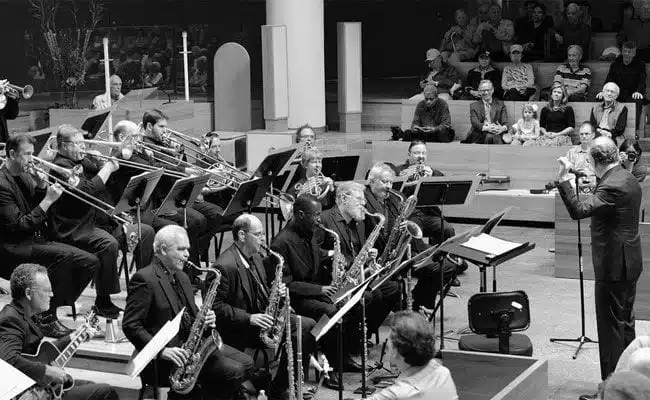
According to John Caps’s liner notes for Henry Mancini: Music for Peter Gunn, half of the fan mail that the late ’50s crime drama Peter Gunn received was actually addressed to composer Henry Mancini. That seems a little hard to believe since so few people know who is responsible for TV’s most popular shows nowadays. But we should take Caps’s word for it since he wrote a book named Henry Mancini: Reinventing Film Music. The Peter Gunn score was a bit of a revelation. The bass clef eighth-note ostinato was the first “riff” that some TV audiences had heard. The blaring horns with their nose dives and triplets represented the first time some of these viewers had ever heard anything “jazzy”.
The press material accompanying this rerecording of Mancini’s score is quick to note that what he composed was not jazz music in the purest sense. The style employed here is instead known as West Coast Cool school, a more palatable backdrop for another form of media. But TV audiences in the late ’50s/early ’60s probably didn’t devote so much as half a thought to the purity of the music. They were too busy being entertained, even energized to some extent. Hard-boiled private investigators and noir itself seemed to have more grit and personality thanks to Mancini’s unforgettable theme music. These days, you could say that the music has outlasted the show itself.
I didn’t know this until recently (and apparently, neither did some members of Harmonie Ensemble New York), but there is an entire suite of music built around the show that Mancini released on a Grammy-winning LP in 1959. The opening theme has been performed many times over by many people, but no one has attempted to cover the rest of the incidental music — until now. Enter Steven Richman and the Harmonie Ensemble New York, who have been scoring big points with old school jazz aficionados by covering Gershwin and Ellington on past releases. Their rendition of the Peter Gunn music is pretty reverent and straightforward, probably because it hasn’t been covered enough at this point to be deconstructed by a hyper-modern ensemble. The electric guitar even imitates Duane Eddy’s slight twang. All the wind instruments dip in the same fashion. At 22 members strong, the Harmonie Ensemble/New York feels no need to give Peter Gunn an upgrade. If anything, Steven Richman probably just wanted more people to be aware of the music apart from the main theme.
That main theme bookends the Henry Mancini: Music for Peter Gunn CD. Apart from the different forms of restrained horn wailing at the end of each, the two performances are nearly identical. In other places, the theme’s elements are paraphrased and rearranged, as on “Fallout”. When I first heard it, I didn’t know if they were going to reprise the main theme or launch into “Let the Good Times Roll”. Mancini’s score does neither, of course. Richman himself uses the word “recycled” to describe the other tracks, normally a pejorative word when describing music. But Henry Mancini was writing for television, and the audience needed some consistency and familiarity to go with their viewing experience if they were going to tune in each week. If slicing and dicing up the main dish meant repeated business, then so be it. Besides, much of it is done on the sly. The gentle, shuffling rhythms and swaying melodies of “Sorta Blue”, “The Brothers Go to Mother’s”, and “The Floater” stand in contrast to the no B.S. drive of the main theme. In fact, much of Mancini’s score is more laid back than the infamous theme lets on. About the boppiest thing here is “My Manne Shelly”, a spritely number dedicated to jazz drummer Shelly Manne.
After witnessing music and film/television become so tightly intertwined over the past 50 years or so, we’ve all become pretty far removed from that “a-ha” moments of discovery. You know, that instance where everything clicks so well together it’s hard to remember a time when the two didn’t coexist. But everyone who had a functioning television set in 1958 got to experience that epiphany. Lucky them, huh? Well, you can’t fault Steven Richman and his ensemble for trying to recreate the moment, even though it’s long gone. At worst, you’ll come down with an acute case of toe-tapping.

